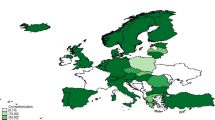Abstract
The increasing relevance of Information and Communication Technologies (ICTs) in medical care is indisputable. This evidence makes it necessary to start studies that analyse the scope these new forms of access to information and understanding of medicine have on the professional activity of the physician, on the attitude and on the knowledge of patients or, on the doctor-patient relationship. The purpose of this study is to explore some of these aspects in a group of physicians whose clinical activity is related to one of the greatest social impact health problems which is the treatment of chronic pain. Starting with the completion of a questionnaire, in the study group it is observed that the interaction between social structure, increase of information flows and ICTs generate transformations in social practices and behaviour of the actors of the health system. Internet is confirmed as an information space on the subject, but is shown as an underutilized space of interaction between the doctor and his patient.

Similar content being viewed by others
References
Nettleton, S., Burrows, R., and O’Malley, L., The mundane realities of the every day lay use of the internet for health, and their consequences for media convergence. Sociology of Health & Illnes. 27:972–992, 2005.
Webster, A., Innovative health technologies and the social: Redefining health, medicine and the body. Curr. Sociol. 50:443–457, 2002.
Powell, J.A., Darvell, M., and Gray, J.A., The doctor, the patient and the world-wide web: how the internet is changing healthcare. J. R. Soc. Med. 96:74–76, 2003.
Powell, J.A., Lowe, P., Griffiths, F.E., and Thorogood, M., A critical analysis of the literature on the internet and consumer health information. J. Telemed. Telecare. 11:41–43, 2005.
Dear, B.F., Gandy, M., Karin, E., Staples, L.G., Johnston, L., Fogliati, V.J., Wootton, B.M., Terides, M.D., Kayrouz, R., Perry, K.N., Sharpe, L., Nicholas, M.K., and Titov, N., The pain course: a randomised controlled trial examining an internet-delivered pain management program when provided with different levels of clinician support. Pain. 156:1920–1935, 2015.
Santana, S., Lausen, B., Bujnowska-Fedak, M., Chronaki, C., Kummervold, P.E., Rasmussen, J., and Sorensen, T., Online communication between doctors and patients in Europe: status and perspectives. J. Med. Internet Res.12(2):e20, 2010. doi:10.2196/jmir.1281 .2010
Cuvillon, P., and Boisson, C., Teletherapeutic drug administration by long distance via internet control: Back to the future? Ann. Fr. Anesth. Reanim. 33:8–9, 2014.
De Lima Verde Brito TD, Baptista RS, de Lima Lopes PR, Haddad AE, Messina LA, Torres Pisa I The collaborative coordination of special interest groups on the telemedicine university network (RUTE) in Brazil. Stud Health Technol 2015; 216:1010, 2015.
Trompetter, H.R., Bohlmeijer, E.T., Veehof, M.M., and Schreurs, K.M., Internet-based guided self-help intervention for chronic pain based on acceptance and commitment therapy: a randomized controlled trial. J. Behav. Med. 38:66–80, 2014.
OECD (2005) Health at a glance. OECD indicators 2005. OECD, Paris
Muriel Fernandez J (2015) Estudio de los usos de internet de los profesionales sanitarios vinculados en el tratamiento del dolor crónico. Tesis Doctoral, Universidad de Salamanca. En: gredos.usal.es/jspui/bitstream/10366/.../DC
Levy, J., and Strombeck, R., Health benefits and risk of the internet. J. Med. Syst. 26:495–510, 2002.
Anderson, J.G., Rainey, M.R., and Eysenbach, G., The impact of cyber healthcare on the physician–patient relationship. J. Med. Syst. 27:67–83, 2003.
Silver, M.P., Patient perspectives on online health information and communication with doctors: a qualitative study of patients 50 years old and over. J. Med. Internet Res. 17(1):e19, 2015. doi:10.2196/jmir.3588.
Love, T., Laier, C., Brand, M., Hatch, L., and Hajela, R., Neuroscience of internet addiction: A review and update. Behav. Sci. 18:388–433, 2015.
Ma, L., Kaye, A.D., Bean, M., and Vo, N., Ruan X (2015) a five-star doctor? Online rating of physicians by patients in an internet driven world. Pain Physician. 18:E15–E17, 2015.
Ferguson, A.M., McLean, D., and Risko, E.F., Answers at your finger-tips: Access to the internet influences willingness to answer questions. Conscious. Cogn. 1:91–102, 2015.
Mars, B., Heron, J., Biddle, L., Donovan, J.L., Holley, R., Piper, M., Potokar, J., Wyllie, C., and Gunnell, D., Exposure to, and searching for, information about suicide and self-harm on the internet: Prevalence and predictors in a population based cohort of young adults. J Affect Di- sord. 1:239–245, 2015.
Schneider, L.H., and Hadjistavropoulos, H.D., When in doubt, ask the audience: potential users’ perceptions of internet-delivered cognitive behavioural therapy for chronic pain. Pain Res. Manag. 19:173–178, 2014.
Walsh, K., Neuroscience education on the internet: the next steps. Malays J Med Sci. 21:75–82, 2014.
Nieto, R., Secondary prevention of chronic pain: can internet help. Pain Manag. 4:285–291, 2014.
Acknowledgements
The study was funded by an aid for research by the Cátedra Extraordinaria del Dolor “Fundación Grünenthal” of the University of Salamanca.
Author information
Authors and Affiliations
Corresponding author
Additional information
This article is part of the Topical Collection on Systems-Level Quality Improvement
Rights and permissions
About this article
Cite this article
Fernandez, J.M., Cenador, M.B.G., Manuel López Millan, J. et al. Use of Information and Communication Technologies in Clinical Practice Related to the Treatment of Pain. Influence on the Professional Activity and the Doctor-Patient Relationship. J Med Syst 41, 77 (2017). https://doi.org/10.1007/s10916-017-0724-5
Received:
Accepted:
Published:
DOI: https://doi.org/10.1007/s10916-017-0724-5




